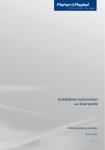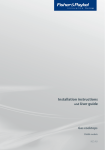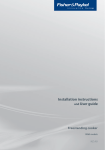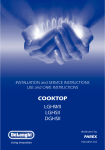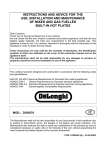Download Fisher & Paykel CG604 User's Manual
Transcript
1 Installation instructions and User guide Gas cooktops CG604 models NZ AU Contents 1 Safety and warnings 2 Installation instructions 6 Introduction Using your cooktop Care and cleaning Troubleshooting Warranty and service Important! SAVE THESE INSTRUCTIONS The models shown in this User Guide may not be available in all markets and are subject to change at any time. For current details about model and specification availability in your country, please go to our website www.fisherpaykel.com or contact your local Fisher & Paykel dealer. 16 18 23 27 28 2 Safety and warnings WARNING! Cut Hazard Beware of sharp edges when handling stainless steel appliances. Failure to use caution could result in injury or cuts. WARNING! Electrical Shock Hazard Before carrying out any work on the electrical section of the appliance, it must be disconnected from the mains. Connection to a good earth wiring system is absolutely essential. Failure to follow this advice may result in death or electrical shock. Important safety precautions Installation Read these instructions carefully before installing or using this product. Please make this information available to the person responsible for installing the product as it could reduce your installation costs. These products are registered: in New Zealand at www.ess.govt.nz and in Australia with AGA at www.gas.asn.au. This appliance must be installed in accordance with these installation instructions, local gas fitting regulations, municipal building codes, water supply regulations, electrical wiring regulations, AS5601 / AG 601 - Gas Installations and any other relevant statutory regulations. This appliance shall only be serviced by authorised personnel. This appliance is to be installed only by an authorised person. Incorrect installation, for which the manufacturer accepts no responsibility, may cause personal injury of damage. Always disconnect the cooktop from mains power supply before carrying out any maintenance operations or repairs. In the room where the cooktop is installed, there must be enough air to allow the gas to burn correctly, according to the current local regulations. Safety and warnings 3 Particular attention shall be given to the relevant requirements regarding ventilation. This product should not be sealed into the bench with silicone or glue. Doing so will make future servicing difficult. Fisher & Paykel will not be liable for costs associated with releasing such a product, nor for repairing damage that may be incurred in doing this. When this product is installed it shall not be used as a space heater, especially if installed in boats or caravans. No combustible material or products should be placed on this product at any time. Do not spray aerosols in the vicinity of this product while it is in operation. 4 Safety and warnings WARNING! Hot Surface Hazard This appliance becomes hot during use. Do not touch the cooktop components, burners, trivets/pan supports or the base when hot. Before cleaning, turn the burners off and make sure the whole cooktop is cool. Failure to do so may result in serious injury. WARNING! Explosion Hazard Do not store flammable materials such as gasoline near the cooktop.Do not spray aerosols near the cooktop during use. Failure to do so may result in death or serious injury. WARNING! Electrical Shock Hazard Switch off the cooktop at the wall before carrying out cleaning or maintenance. Failure to do so may result in death or electrical shock Safety and warnings 5 Important safety precautions Operation Children, or persons with a disability which limits their ability to use the appliance, should have a responsible person to instruct them in its use. The instructor should be satisfied that they can use the appliance without danger to themselves or their surroundings. If the electrical supply cord is damaged, it must only be replaced by an authorised person. Ensure that the electrical connection plug is accessible after installation. This appliance should be connected to a circuit that incorporates an isolating switch providing full disconnection from the electricity supply. Do not use an asbestos mat or decorative covers between the flame and the saucepan as this may cause serious damage to your cooktop. Do not place aluminium foil or plastic dishes on the cooktop burners. Do not let large saucepans or frying pans overlap the bench as this can deflect heat onto your benchtop and damage the surface. Do not let large saucepans, frying pans or woks push any other pans aside. This could make them unstable or deflect heat onto your benchtop and damage the surface. Do not use a steam cleaner for cleaning this cooktop. Saucepan handles may be hot to touch. Ensure saucepan handles do not overhang other gas burners that are on. Keep handles out of reach of children. Keep children away from the cooktop when it is in use. Household appliances are not intended to be played with by children Do not stand or place heavy objects on this appliance. After use, ensure that the knobs are in off position. This appliance shall not be used as a space heater, especially if installed in marine craft or caravans. The use of a gas cooking appliance results in the production of heat and moisture in the room in which it is installed. Ensure the kitchen is well ventilated. Keep natural ventilation holes open or install a mechanical ventilation device (mechanical extractor hood). Prolonged intensive use of the appliance may call for additional ventilation, for example opening of a window, or more effective ventilation, for example increasing the level of mechanical ventilation where present. After having unpacked the appliance, check to ensure that it is not damaged. In case of doubt, do not use it and consult your supplier or a professionally qualified technician. Packing elements (i.e. plastic bags, polystyrene foam, nails, packing straps, etc.) should not be left around within easy reach of children, as these may cause serious injuries. Some appliances are supplied with a protective film on steel and aluminium parts. This film must be removed before using the appliance. 6 Installation instructions This cooktop has been designed and constructed in accordance with the following codes and specifications: AGA101 (AS 4551) Approval Requirements for Domestic Gas cooking appliances AS/NZS 60335-1 General Requirements for Domestic electrical appliances AS/NSZ 60335-2-6 Particular Requirements for Domestic electrical cooking appliances AS/NSZ 1044 Electromagnetic Compatibility Requirements. The installation shall comply with the dimensions in Figures 1 and 2, bearing in mind that: A minimum clearance of 20 mm has to be kept between the bottom of the cooking hob and the top of an appliance or a shelf. To ensure this clearance mount the spacers, supplied with the appliance, as shown in the figure 3. Overhead clearances - In no case shall the clearance between the highest part of the hob and a range hood be less than 600 mm, or for an overhead exhaust fan, 750 mm. Any other downward facing combustible surface less than 600 mm above the highest part of the hob shall be protected for the full width and depth of the cooking surface area in accordance with local regulations in force. However, in no case shall this clearance to any surface be less than 450 mm. Side clearances - Where the dimension from the periphery of the nearest burner to any vertical combustible surface is less than 200 mm, the surface shall be protected in accordance with with local regulations in force to a height of not less than 150 mm above the hob for the full dimension (width or depth) of the cooking surface area. Where the dimensions from the periphery of the nearest burner to any vertical combustible surface is less than 200 mm, the horizontal surface shall be greater than 10 mm below the surface of the hob, or the horizontal surface requirement above. Protection of combustible surfaces - Local regulations in force specify that where required protection shall ensure that the surface temperature of the combustible surface does not exceed 65 °C above ambient. The fixing of 5 mm thick ceramic tiles to the surface or attaching fire resistant material to the surface and covering with sheet metal with minimum thickness of 0.4 mm should be satisfactory. 580 500 34 200 Fig. 1 560 480 0 –2 0 –2 Cooktop dimensions Cut-out dimensions Width 580 mm Depth 500 mm Depth below mounting surface 60 34 mm Width 560 mm 0 –2 Depth 480 mm 0 –2 Installation instructions Clearances 450 mm 750 mm Installation clearances and protection of combustible surfaces shall comply with the current local regulations e.g. AG 601 (AS 5601) - Gas Installations code. 200 m m min 500 mm 20 mm Fig. 2 Fig. 3 in mm m 60 7 8 Installation instructions Fastening the installation brackets (fig. 4) Each cooktop is provided with an installation kit including brackets and screws for fastening the top to fixture panels from 2 to 4 cm thick. Turn the cooktop upside down and fasten the brackets “F and R” to the appropriate socket holes, without tightening the screws “B” for the moment. Make sure that the brackets are fastened as shown in figure 4. Fastening the cooktop (fig. 4) Spread the sealing material “C” out along the fixture hole, making sure that the junctions overlap at the corners. Insert the cook top into the hole and position it correctly. Adjust the position of the brackets “F and R” and tighten screws “B” to block the cooker top firmly in position. With a sharp cutter or trimmer knife trim the excess sealing material around the edge of the cooktop. R Gas inlet pipe R F NT FRO F Front side Rear side C C B Fig. 4 F 40 mm min. R B 20 mm min. 40 mm min. 20 mm min. 0 –2 0 –2 Installation instructions 9 Gas supply The connection must be executed by an authorised person according to the relevant standards. Before connecting the appliance to the gas main, mount the brass conical adaptor onto the gas inlet pipe, upon which the gasket has been placed (figures 5 and 6). Conical adaptor and gasket are supplied with the appliance (packed with conversion kit for use with Natural gas or Universal LPG). This appliance is suitable for use with Natural Gas or Universal LPG. (Check the “gas type” sticker attached to the appliance). For Natural Gas models the gas supply is connected to the pressure regulator which is supplied with the appliance (fig. 5). Adjust the regulator to obtain a test point pressure of 1 kPa with the two semi-rapid burners operating at the maximum. For Universal LPG models the gas supply is connected to the test point adaptor which is supplied with the appliance (fig. 6) and ensure that the supply pressure is regulated to 2.75 kPa. Do NOT force the ”elbow“ rotation prior to loosening nut. Do NOT over tighten the nut at the ”elbow“. Important! This appliance IS NOT SUITABLE for installation with a hose assembly. Gas connection for UNIVERSAL LPG Gas connection for NATURAL GAS Gas inlet pipe Test point Gasket Gasket Brass conical adaptor (Thread tight: use suitable seal) Brass conical adaptor (Thread tight: use suitable seal) Test point adaptor Gas regulator Test point Fig. 5 Fig. 6 10 1 Installation instructions After connecting the gas supply, check the piping and connections for leaks using a soap and water solution. The presence of bubbles indicates a leak, tighten or replace connections as appropriate. Important! Do not use any naked flame to check for leaks. 2 3 4 5 6 7 The operation of the appliance MUST be tested before leaving. Adjust the test point pressure or supply pressure to the value which is appropriate for the gas type. Turn on the appliance gas controls and light each burner. Check for a well defined blue flame without any yellow tipping. If any abnormality is evident then check that the burner cap is located properly and the injector nipple is aligned correctly. Check the minimum burner setting by quickly rotating the gas control knob from the maximum to the minimum position, the flame must not go out. If adjustment is required carry out the “minimum burner setting adjustment” section following. If satisfactory performance cannot be obtained, the installer shall check the installation and notify the local gas supply authority for a gas supply problem, or if it is an appliance problem, our Customer Service Centre should be called to obtain the nearest authorized Service Agent. Where the appliance data plate cannot be easily read with the appliance in the installed position the duplicate data plate must be attached to adjacent surface and the duplicate Universal LPG conversion label should also be included where a Universal LPG conversion has been completed. Table for the choice of the injectors Natural Gas Universal LPG 1.0 2.75 Test point Pressure [kPa] BURNER Auxiliary Injector Orifice Dia. Gas Consumption Injector Orifice Dia. Gas Consumption [mm] [MJ/h] [mm] [MJ/h] 0.85 3.60 0.53 3.60 Semi-rapid 1.12 6.30 0.70 6.30 Rapid 1.45 10.30 0.91 10.80 Wok 1.65 13.00 0.95 11.90 Installation instructions 11 Conversion procedure (to convert to Universal LPG) replacing the injectors. Important! The conversion procedure must be carried out only by an authorised person. This appliance is suitable for use with Natural gas or Universal LPG (check the “gas type” sticker attached to the appliance). See the “Table for the choice of injectors” for the nominal gas consumption and injector size details. To replace the injectors proceed as follows: Remove pan supports and burners from the cooktop. Using a spanner, remove the injector J (figs. 7, 8) and replace it with one according to the gas type (see “Table for the choice of injectors”). Affix to the appliance the warning label stating that the cooktop has been converted for use with Universal LPG (supplied with the Universal LPG conversion kit.). A second Universal LPG conversion label should also be affixed to an adjacent surface along with the duplicate data plate. Important! If the cooktop is suitable for use with Natural gas and must be converted for use with Universal LPG, before connecting to gas main remove the appliance gas regulator and replace with test point adaptor (see fig. 5, 6) If the cooktop is suitable for use with Universal LPG and must be converted for use with Natural gas, before connecting to the gas main remove the appliance test point adaptor and replace with gas regulator (see figs. 5, 6). Note: Gas regulator and test point adaptor are supplied with the appliance (packed with conversion kit) The burners are designed so that regulation of primary air is not required. J Fig. 7 J Fig. 8 12 Installation instructions Minimum burner setting adjustment When changing from one type of gas to another, the minimum tap output must also be correct, considering that in this position the flame must be about 4 mm long and must remain lit even when the knob is turned sharply from the maximum to the minimum position. The adjustment is performed with the burner lit, as follows: Turn the knob to the minimum position. Remove the tap knob. On gas valves provided with adjustment screw in the centre of the shaft (fig. 9) Using a screwdriver with max. diameter 3 mm, turn the screw inside the tap until the correct setting is obtained. On gas valves provided with adjustment screw on the valve body (fig. 10) Turn the screw “A” to the correct setting with a screwdriver. In models with a gas-lighter incorporated into the knob, turn screw “A” via the hole in the microswitch. For Universal LPG, tighten the adjustment screw completely. Lubricating the gas taps If a gas tap is difficult to turn, disassemble it, clean it carefully with petrol and spread a little high-temperature-resistant grease on it. A Fig. 9 Fig. 10 Installation instructions 13 Important! Installation must be carried out according to the manufacturer's instructions. Incorrect installation may cause harm and damage to people, animals or property, for which the manufacturer accepts no responsibility. Before carrying out any work on the electrical section of the appliance, it must be disconnected from the mains. Connection to a good earth wiring system is absolutely essential. The manufacturer accepts no responsibility for any inconvenience caused by failure to comply with this rule. Electrical requirements The appliance must be connected to the mains checking that the voltage corresponds to the value given in the rating plate and that the electrical cable sections can withstand the load specified on the plate. The plug must be connected to an earthed socket in compliance with safety standards. If the appliance is supplied without plug, fit a standard plug which is suitable for the power consumed by the appliance. The wires in the power cable are coloured in accordance with the following code: Green/Yellow = Earth, Blue = Neutral, Brown = Active. If the colours of the wires in the power cable to the appliance do not correspond with the coloured markings identifying the terminals in the junction terminal, proceed as follows: 1 2 3 The wire which is coloured green and yellow must be connected to the terminal marked E (Earth) or coloured Green. The wire which is coloured blue must be connected to the terminal marked N (Neutral) or coloured Black. The wire which is coloured brown must be connected to the terminal marked L (Live) or A (Active) or coloured Red. A suitable disconnection switch is incorporated in the permanent wiring, mounted and positioned to comply with the local wiring rules and regulations. The switch must be of an approved type installed in the fixed wiring and provide a 3 mm air gap contact separation in all poles in accordance with the local wiring rules. In Australia and New Zealand, a switch of the approved type with a 3 mm air gap must be installed in the active (phase) conductor of the fixed wiring. The power supply cable must not touch the hot parts and must be positioned so that it does not exceed 50°C above ambient. Once the appliance has been installed, the switch or socket must always be accessible. If the supply cord is damaged it must be replaced by the manufacturer or its Service Agent or a similarly qualified person in order to avoid a hazard. N.B. The connection of the appliance to earth is mandatory. If the installation requires alterations to the domestic electrical system call a qualified electrician. He should also check that the socket cable section is suitable for the power drawn by the appliance. 14 Installation instructions Important! Replacing the power cord must be done by a qualified electrician in accordance with the instructions supplied by the manufacturer and in compliance with established electrical regulations. Electric diagrams key PA A M CA Ignition switch Ignition coil Terminal block Spark electrode CA CA CA CA M N L A PA PA PA PA Fig. 11 15 16 Introduction About your new cooktop Thank you for buying a Fisher & Paykel gas cooktop. Once it is installed and ready to use, you will want to know everything about it to make sure you get excellent results right from the start. This guide introduces you to all its special features. We recommend you read the whole guide before using your new cooktop, for both safety and cooking success. For more information, go to www.fisherpaykel.com Before using your new cooktop Before using your new cooktop, please: Read this user guide, taking special note of the ‘Safety and warnings’ section. Plug the cooktop into the electricity supply and turn it on so the electronic ignition will work. Introduction 2 17 2 5 3 Fig.1 CG604 with rapid burner (no flame failure safety feature) 2 1 2 2 2 5 4 5 4 1 Fig.2b CG604 with wok burner (no flame failure safety feature) Fig.2a CG604 with wok burner ( with flame failure safety feature) 1 2 3 4 5 Auxiliary burner Semi-rapid burner Rapid burner Wok burner Cooktop controls 1 18 Using your cooktop Gas burners The knob (Fig. 3) controls the flow of gas through the safety tap. OFF = closed valve = maximum aperture or flow = minimum aperture or flow You can choose to cook at any heat between and OFF. and , but never between Fig. 3a Burner knob and symbols (models without flame failure safety feature) Fig. 3b Burner knob and symbols (models with flame failure safety feature) Using your cooktop 19 Lighting the cooktop 1 2 3 Choose the control knob for the burner you want to use. Press the knob down gently and turn it anticlockwise to the position. The ignitors on all the burners will spark. Flame failure models only: Hold down the knob for approximately ten seconds after the burner has lit. Releasing the knob too soon will extinguish the flame. Adjust the flame anywhere between the and positions. Do not adjust the flame between and OFF. Note: If the burner does not light within 15 seconds, turn the control knob off and wait at least one minute before trying again. 1 2 Fig. 4a Pushing then turning the control knob (models without flame failure safety feature) After use, always turn the knobs to the off position. For models without flame failure, you should also close the cock valve on the gas bottle or the main gas supply line. Flame failure safety feature (some models only) Some cooktop models have a flame failure safety device. These models have a flame failure probe as well as the ignitor (see Fig 5). The flame failure probe cuts off the gas supply to the burner if the flame is blown out. Fig. 4b Pushing then turning the control knob (models with flame failure safety feature) When lighting the burner on flame failure models, hold down the knob for approximately ten seconds after the burner has lit. Releasing the knob too soon will extinguish the flame. If the flames are accidentally extinguished, turn off the burner and do not try to light it again for at least one minute (to allow the gas to disperse). 20 Using your cooktop If the cooktop does not light If the cooktop does not light, check that: The cooktop is plugged in and the electricity is switched on. The gas is turned on. Flame failure models only: You have held down the knob for at least ten seconds. The ignitors are sparking. If the ignitors are not sparking, they may be dirty or wet. Clean them with a toothbrush and methylated spirits, as shown in Fig. 5. Flame failure probe (flame failure models only) Ignitor Fig.5 Cleaning the ignitor and probe Using your cooktop 21 If the flame is irregular If the flame is yellow or irregular, check that the burner parts, including the burner cap, are: Clean and dry. Positioned correctly as shown in figs. 9 and 10. See also ‘Troubleshooting’. Choosing a burner Use flat-bottomed pans, and make sure that they match your burner, as shown in the following table. A small pot on a large burner is not efficient. Diameters of pans which may be used on the cooktop Burners Minimum Maximum Auxiliary 12 cm 14 cm Semi-rapid 16 cm 24 cm Rapid 24 cm 26 cm 26 cm 28 cm Wok Maximum diameter for woks: 36 cm Do not use pans with concave or convex bases Fig. 6 Efficient and inefficient pot sizes. 22 Using your cooktop Wok stand - models fitted with wok burner only (fig. 8) The wok stand fits over the pan support for the wok burner. Important! Using a wok without the stand may cause the burner to operate incorrectly. Do not use the stand for ordinary, flat-bottomed saucepans. The wok stand MUST BE PLACED ONLY over the pan support for the wok burner. WRONG Fig. 7 Incorrect use of wok on burner Important! The cooktop becomes very hot during operation. Keep children well out of reach. CORRECT Fig. 8 Correct use of wok on wok stand over burner Care and cleaning 23 General advice Maintenance Period Description Daily Clean gas cooktop as per following instructions. Monthly Remove all burner parts, and clean using a non-abrasive detergent. Rinse in cold water, dry thoroughly, and replace. Clean the ignitor and probe carefully, using a toothbrush and methylated spirits. (Note: probe is only on flame-failure models) Every 3-4 years Contact your local authorized gas Service Agent to perform a thorough check on all gas components on the gas cooker. Before you begin cleaning you must ensure that the cooktop is switched off. Clean the cooktop regularly – do not let stains become burnt on. Allow the appliance to cool down before cleaning. Avoid leaving acidic substances (lemon juice, vinegar etc.) on the surfaces. The control knobs may be removed for cleaning but care should be taken not to damage the seal. Do not clean cooktop parts in a self-cleaning oven. Do not use steam cleaners because the moisture could get inside the appliance making it dangerous. For stubborn stains, see the ‘Cleaning chart’. Enamelled parts Clean the enamelled parts with a sponge and soapy water only or other non-abrasive products. Dry preferably with a microfibre or soft cloth. If acidic substances such as lemon juice, tomato sauce, vinegar etc. are left in contact with the enamel for a long time they will damage the surface. Stainless steel surfaces Stainless steel parts should be rinsed with water and dried with a microfibre or soft cloth. Dry thoroughly to avoid leaving water marks. For extra shine on stainless steel, use a stainless steel polish. Clean brushed stainless steel in the direction of the grain. For persistent dirt, use specific non-abrasive products available commercially or a little hot vinegar. Note: regular use could cause discolouring around the burners, because of the high flame temperature. 24 Care and cleaning Burners and pan supports You can remove and clean these parts with hot soapy water or other appropriate products - see ‘Cleaning chart’. After cleaning, check that the burners and their flame spreaders are dry before replacing correctly. It is very important to check that the burner flame spreader and the cap have been correctly positioned. Failure to do so can cause serious problems. Note: To avoid damage to the electric ignition do not try to light the cooktop when the burners are not in place. Replacing the burners It is very important to check that the burner flame spreader “F” and the cap “C” have been correctly positioned (see fig. 9). Failure to do so can cause serious problems. Check that the ignitor S (figs. 9 and 11) is always clean to ensure trouble-free sparking. In the models with the flame failure safety device, check that the probe T (figs. 9 and 11) next to each burner is always clean to ensure correct operation of the safety valves. Both the ignitor (S) and probe (T) must be very carefully cleaned using a toothbrush and methylated spirits. C F T* S Fig. 9 Correct line-up of the burner parts * Models with flame failure device only Fig. 10 Replacing the burner cap Care and cleaning 25 Replacing the wok burner To replace the wok burner: 1 Fit the burner ring to the housing as shown by the arrow in fig. 11. Make sure the burner is not able to rotate (fig. 12) S T Fig. 11 Fitting the burner ring to the housing. A B Fig. 13 Incorrect and correct positioning of cap and ring Fig. 12. Correct positioning of cap and ring 26 Care and cleaning Cleaning chart Cooktop part Trivets/pan supports, burner caps Cleaning Important Hot soapy water and nylon scourer. Soap removeable parts in a solution of biological clothes-washing detergent. Mild abrasive cream cleaners. Fume-free or heavy-duty oven cleaners (follow manufacturer’s instructions). Always allow cooktop parts to cool completely before cleaning them. Burner parts Hot soapy water. To clear the holes use a stiff nylon brush or wire eg straight-ended paper clip. Mild abrasive cream cleaners. Reassemble the burner parts correctly. Control knobs Hot soapy water and a soft cloth. Stainless steel base Soak stains under a hot soapy cloth, rinse and dry thoroughly. Hard water spots can be removed with household white vinegar. Non-abrasive stainless steel cleaners. Regular use of a stainless steel polish will reduce fingerprints and other marks. Heavy soiling can be removed with fume-free or heavy-duty oven cleaner (follow manufacturer’s instructions). Always apply minimal pressure with abrasive cleaners. Clean spills regularly before they become burnt on. Never use harsh/abrasive cleaning agents as they will damage the stainless steel finish. Chlorine or chlorine compounds in some cleaners are corrosive to stainless steel and may damage the appearance of your cooktop. Check the label on the cleaner before using. The graphics are etched onto the steel by laser and will not rub off. Enamel base Use soft cloth or no-abrasive sponge and sopay water. Do not use abrasive products. Clean spills regularly before they become burnt on. Ignitors Toothbrush and methylated spirits. Probe (in models with flame failure safety valves) Toothbrush and methylated spirits. A dirty or wet ignitor will prevent the burner lighting efficiently. A dirty probe may prevent the safety valve from working effectively. Troubleshooting 27 Troubleshooting chart Problem Possible solutions My cooktop does not light Check the cooktop is plugged in and the electricity is switched on. Check the gas supply valve is turned on and the supply to the house is working. You should hear the gas when you turn a burner on. The ignitors may be dirty. Clean them with a toothbrush and methylated spirits. The burner parts may not be located properly. Check the assembly and make sure the burner cap is sitting flat. My burner flames are yellow or hard to start The burner parts may not be located properly. Check the assembly and make sure the burner cap is sitting flat. If you use bottled gas this may indicate you are getting near the end of the bottle. Check the burner parts are clean and dry. The gas pressure may not be at the correct level. Check with your service person or installer. Your cooktop may not be set up for the gas you are using. Check this with your service person or installer. One of my burners has an uneven flame Check the burner parts are clean and dry. Check the assembly and make sure the burner cap is sitting flat. The flame goes out at low settings The gas supply pressure may be low. Check this with your service person or installer. The low setting may have been adjusted incorrectly. Check this with your service person or installer. My burners do not turn down much (when running on bottled gas or LPG) Your cooktop may not have been adjusted correctly. Check this with your service person or installer. The flame tips are very yellow Call your service person to service the cooktop. There are objectionable odours Call your service person to service the cooktop. The flame appears to lift off the burner Call your service person to service the cooktop. There is an electricity failure If there is an electricity failure, you can still use your cooktop. Light the burners by holding a match close to the side of the burner and turning the control knob to the High position. Wait until the flame is burning evenly before adjusting. 28 Warranty and service Before you call for service or assistance ... Check the things you can do yourself. Refer to the installation instructions and your user guide and check that: 1 2 Your product is correctly installed. You are familiar with its normal operation. If after checking these points you still need assistance, please refer to the Service & Warranty book for warranty and after-sales service details or contact us through our website: www.fisherpaykel.com Product details Fisher & Paykel Ltd Model Serial no. Date of purchase Purchaser Dealer Suburb Town Country 30 Copyright © Fisher & Paykel 2007. All rights reserved. The product specifications in this booklet apply to the specific products and models described at the date of issue. Under our policy of continuous product improvement, these specifications may change at any time. You should therefore check with your Dealer to ensure this booklet correctly describes the product currently available. www.fisherpaykel.com NZ AU Gas cooktop installation and user guide Published: 11/2007 F&P Part No. 599371 C Elba Part No. 1102964 - ß4
































